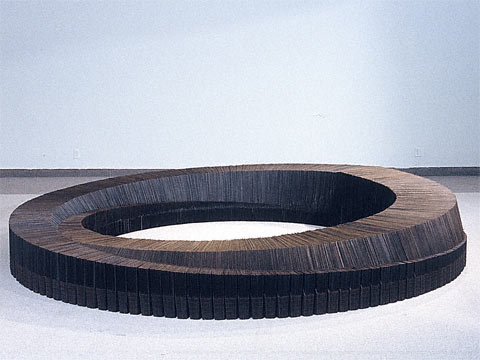
Genie Shenk, "Ring," 1990-1999, constructed from 150 contiguous books sewn together from 6,000 sheets of industrial paper, 20 inches X 11 feet in diameter.
In today's chaotic art world, there are no holds barred. Anything goes. A cursory glance at recent listings reveals that visitors might find themselves in the midst of many virtual reality installations, thanks to advanced digital electronics. Or, conversely, they may encounter an exhibit of synthetic hair balls, photos of paint peeling off the wall, displays of toy soldiers and contemporary comic book characters, or gold-plate renderings of bar codes (to name only a few).
Regardless of form, content, concept or materials, however, all artists share one thing. After centuries of art-making, "creative imagination" remains at the top of the list.
“Novel Constructions: Contemporary Artists Create Monumental Books” is a prime example of this timeless prerequisite. Visitors stand before these sculptures and installations and exclaim out loud, "Oh my God, what could have inspired that one?" What elicits these reactions is the sight of eight outstanding constructions by six female artists who are well-known in the "book art" genre. Each of them was hand-picked by curator Jean Clad, an artist herself, who--fascinated by the myriad possibilities that result from combining the two disciplines--has organized many book art exhibits across the country.
Installed at the entrance of the museum is "Black and White." A giant-sized, nine-foot-tall book by Beatriz Mejia-Krumbein, it contains multiple, moveable burlap pages with scenes that depict physical violence or emotional trauma caused by hatred and racism. Executed in broad, expressionistic strokes of thick layered paint, this artbook introduces visitors to the exhibit and gives them a taste of what's to come.
You can actually walk inside of Edith Abeyta's 10-foot square installation. Called "208" (Marie Antoinette's actual prison number), it's a recreation of the cell in which the notorious French queen was locked before her execution. All four walls and ceiling are papered with pages from her diary; while detritus, stained straw, a box of bones, and other metaphoric objects are scattered about the room. Equally astonishing is a work by Cheryl Sorg, who has taken copies of Homer's "The Odyssey" and cut them up--page by page, line by line, word for word--to form two labor intensive, all-over designed, eight-foot labyrinths. Titled "Sing in me, Muse, and through me tell the story," they hang from the ceiling in intricate, interwoven patterns that evoke Odysseus' mythical journey.
Although each artist approaches her work in a distinctly different manner, a spiritual aura is evoked throughout the gallery by their mutual search for meaning.
"Monumental" is certainly the right word for Genie Shenk's black "Ring," which is constructed from 6,000 sheets of industrial tar paper sewn into waves of concentric circles that some people refer to as "sacred geometry." With its imposing 11-foot diameter, Shenk's otherworldly image sits silently on the floor, reminiscent of Navajo or Stonehenge archeology. Today this timeless shape has been recognized as a symbol for "sustainable change."
Carol Shaw-Sutton, who is also chair of the CSU Long Beach Fiber Program, calls her eight-foot-long book "Longitude." Created in the form of a scroll, this work contains digital photographs of hands woven into fabric that stretches across a long table. What begins as individual hands that belong to her husband, children, friends, students, neighbors, and workers becomes a collection of overlapping images that touch each other when the fabric is rolled up. In addition, the hands are overlaid with the words of a universal prayer for healing, humanity, and world peace.
You have to see "Detritus" to believe it, only to discover that the facts behind Mary Ellen Long's installation are as exciting as the finished project. Using essential ingredients from nature, Long has created a faux forest that stretches the length of the gallery. Lying on the floor of this make-believe wilderness are seven hand-made paper books constructed from decomposing paper. Displayed among fallen leaves, they lay opened at the base of cast-paper trees that range from 1 to 7 feet tall. Every year for the past 18 years, Long stacked pages of handmade paper outside her Colorado studio before it snowed. In the spring, after the snow has melted, she retrieves the paper and goes to work. Noting the transformation that has taken place due to nature, time, and decay, Long uses the paper as material to recreate her forest scene. Now, almost two decades later, "Detritus" culminates her annual ritual, as well as an exceptional exhibition.
Published courtesy of ArtScene
